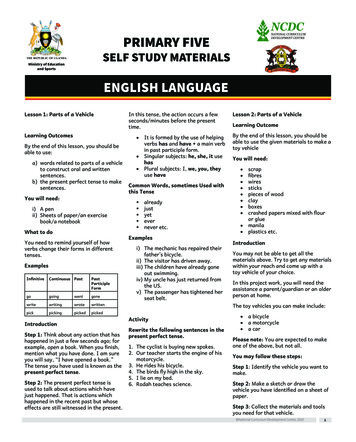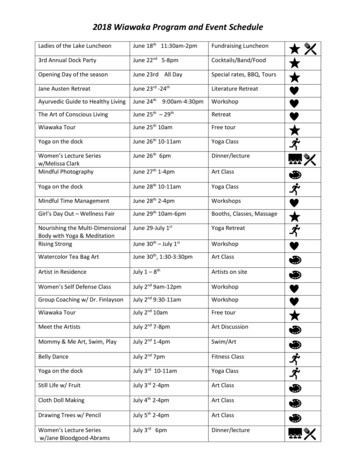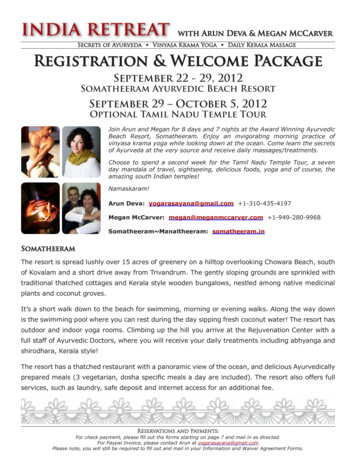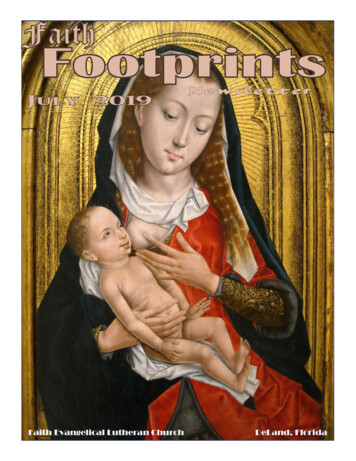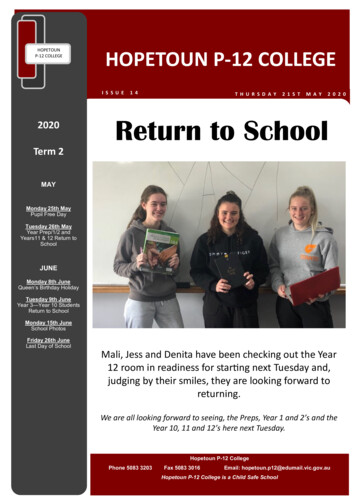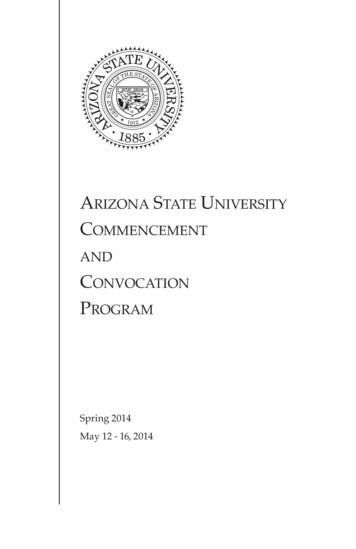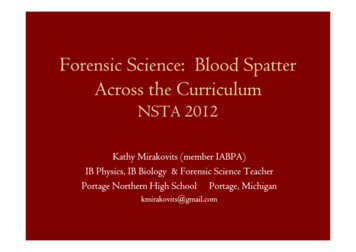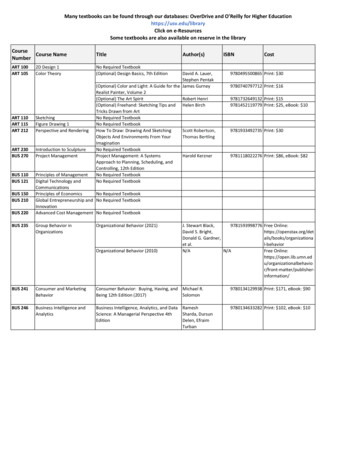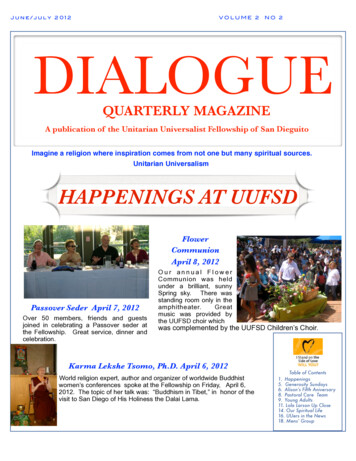
Transcription
J u n e / j u l y 2 0 1 2!VOLUME 2NO 2DIALOGUEQUARTERLY MAGAZINEA publication of the Unitarian Universalist Fellowship of San DieguitoImagine a religion where inspiration comes from not one but many spiritual sources.Unitarian UniversalismHAPPENINGS AT UUFSDFlowerCommunionApril 8, 2012Passover Seder April 7, 2012Over 50 members, friends and guestsjoined in celebrating a Passover seder atthe Fellowship. Great service, dinner andcelebration.Our annual FlowerCommunion was heldunder a brilliant, sunnySpring sky. There wasstanding room only in theamphitheater.Greatmusic was provided bythe UUFSD choir whichwas complemented by the UUFSD Children’s Choir.Karma Lekshe Tsomo, Ph.D. April 6, 2012World religion expert, author and organizer of worldwide Buddhistwomen’s conferences spoke at the Fellowship on Friday, April 6,2012. The topic of her talk was: “Buddhism in Tibet,” in honor of thevisit to San Diego of His Holiness the Dalai Lama.Table of Contents1. Happenings5. Generosity Sundays6. Alison’s Fifth Aniversary8. Pastoral Care Team9. Young Adults11. Lola Larson Up Close14. Our Spiritual Life16. UUers in the News18. Mens’ Group
j u n e 2 0 1 2!volume 2no 2Drum Circle April 14, 2012Vagina Monologues CastTwenty-nine people gathered in Founders Hall for ajoyous hour and half of drumming. Experience wasunnecessary as instructor Frank Lazzaro ledeveryone, novices and experienced drummers, for awonderful musical experience. Here’s hoping thatthis will be the first of many drum circle sessions atthe Fellowship.Director: Danielle DeCarloIntroduction – Alejandra Chan, RenaeGreig and Kristen Magnuson“Hair”- Ashley E. Phillips“Wear and Say”- Alejandra Chan, RenaeGreig and Kristen Magnuson“The Flood”- Lola Larson“Vagina Workshop”- Diane Masser-FryeVagina Happy Fact- Katarina Young“Because He Liked to Look At It”Caroline ChamalesNot-So-Happy-Fact- Katarina Young"What If I Told You I Did Not Have aVagina"- Laura Colban“My Angry Vagina”- Kristen Amicone“My Vagina Was My Village”- Vivian Chandler“The Little Coochi Snorcher ThatCould”- Louise L. Garrett“Reclaiming Cunt”- Beverley ConnerA six-year-old girl was asked -ChelseaKanzler“The Woman Who Loved to MakeVaginas Happy”- Alison Crotty“I was There In the Room”- Betsy Gilpin"For My Sisters inPORTAUPRINCEBUKAVUNEWORLEANS”-Christina MonroeIntroducing Monologues- DarleneKanzlerMusical Guest - Kerry GetzLights and Sound- Nathan ChongThe UUFSD raised 2000 for theEncinitas CRC, Carol's House,El Nido Transitional Apartments,Domestic Violence Recovery Program,& The Women of Haiti.V-Day is a global activist movement to endviolence against women and girls. V-Day isa catalyst that promotes creative events toincrease awareness, raise money, andrevitalize the spirit of existing anti-violenceorganizations. V-Day generates broaderattention for the fight to stop violenceagainst women and girls, including rape,battery, incest, female genital mutilation(FGM), and sex slavery. In 2011, over5,800 V-Day benefit events were producedby volunteer activists in the U.S. andaround the world, educating millions ofpeople about the reality of violence againstwomen and girls.The V-Day movement is growing at a rapidpace in 140 countries from Europe to Asia,Africa, the Caribbean and all of NorthAmerica.2
j u n e 2 0 1 2!volume 2no 2CINCO DE MAYO FUNDRAISERCINCO DE MAYO FUNDRAISER COMMITTEEStanding, left to right: Judy Sherman, John Sherman,Livia Walsh, Cheryl Sims, Maria Penny, Judy Sterling, IrvHimelblau. Seated, left to right: Caroline DeMar, DeniseClark, Louise Garrett. Not present: Monique Kunewalderand Betsy Gilpin.The Cinco de Mayo Fundraiser Committee had reason to celebrate as the Fellowship had its most successfulfundraiser to date. Well over a hundred people came and partook of the celebration.The trifecta, effort - fun financial success, is to be heralded. Over 21,000.00 was raised. Above all, everyone had a great time . The foodwas delicious, the decorations outstanding, the music terrific, the mood, fantastic and our members generous.3
j u n e 2 0 1 2!volume 2no 2Coming of Age Ceremony, May 13, 2012Ten of our youth completed the Coming of Age 2012 Program. They are: Daria Miller, David Linn, Erik Jockin,Ethan Boutelle, Sam Blakistone, Siena Elvins, Skye Mirandon, Torrey Mau, Tristan Pollner and Zachary Kanzler.The congregation was made proud once again by their maturity, poise and efficiency as they conducted the COACeremony at the Fellowship, from the prelude, gathering music, call to worship, intergenerational sharing, and theirfantastic “Faith Statements.” They are a testimony to our outstanding RE Program, led by our RE Director AlisonCrotty and the COA coordinator, Darlene Kanzler.Linda Luisi Art Exhibit - March /April, 2012Linda’s training began at the School of the Museum of Fine Arts, Boston(Tufts University: BFA Degree). She has over 25 years experiencecreating custom paintings and murals for corporations, hospitals, andresorts across the United States. Her art depicts lush jungle scenery,medical graphics, detailed botanicals, whimsical animals, and many othersubjects.As an instructor, Linda shares her expertise with a lighthearted and funapproach. She is known for the individual attention she gives eachstudent: experienced artists and beginners.Walking with the Buddha, May 16, 2012Over forty people were in attendance as acclaimed Buddhist teacher,scholar, guide and activist Shantum Seth presented a memorablepictorial journey through time to India’s ancient “Middle Country,”touching down at each of the important places where the Buddha livedand taught 2600 years ago. Shantum brought this long lost world andits timeless teachings to vibrant life, merging the importance and beautyof ancient and contemporary India into his presentation. Shantumanswered a wide diversity of questions, ranging from the general to thespecifics about Buddhism, and the interplay between the culture of Indiaand Buddhism and other religions of India.4
j u n e 2 0 1 2!volume 2no 2Life Becomes Art-The Hmong DiasporaThe Publicity and Social Action Committees hosted a reception and socialaction forum on Monday, May 21, from 7:00-9:00 p.m. in Fellowship Hall. Thirtyeight people attended the event which included explanations of the beautifultapestries and photographs and the history of the Hmong relocation in California.Bob Montgomery, Director of the San Diego branch of the International RescueCommittee (IRC) joined Roger and Nancy Harmon. Also in attendance were Buaand Xiongh Thao and their son, Phillip Thao, a Hmong family that Roger andNancy befriended in a refugee camp in the Philipines, and True VanHou from theLao Hmong Family Association of San Diego. The accounts of their experiencescoming to California added a much appreciated human element to the discussion.The June Generosity Sunday, a joint sponsorship of the YRUU and the SocialAction Committee will be donated to “My Library,” a nonprofit organization thatenables Hmong and other Laotian youth to enhance tjeir school studies .GENEROSITY SUNDAYSMarch Generosity Sunday:Interfaith Community Services: 572April Generosity Sunday: WorldBicycle Relief : 522 May Generosity Sunday:Coming of Age Donationto the Terris Family: 830UUFSD’s March Generosity Sunday benefited North County veteransserved by Interfaith Community Services’ Fairweather Lodge.The Fairweather Lodge is a research driven recovery-oriented housingmodel that offers shared housing and shared employment for persons withmental illness. Its goal is to provide emotional support, a place to live, andemployment for its members.Working with suppliers to improve bicycle design while ensuring allchanges are culturally appropriateEnhancing distribution with local sourcing, manufacturing orassembly whenever possiblePartnering with existing non-governmental organizations andgovernment and community based organizationsTraining mechanics in maintenance and repair while strengthening theexisting supply of spare partsMeasuring and evaluating the impact of bicycles and communicatingthe results to improve programs and increase awarenessThe Coming Of Age youth became aware of a family with special financial needs.Diegueno Middle School student, George Terris, was diagnosed with Ewings Sarcoma, aform of bone cancer, after a soccer injury revealed tumors in his leg. He has sincebeenfound to have tumors in his lungs also. During George’s long treatment, his family losttheir business and suffered other difficult trials. George’s father has had to leave newjobs in order to assist with George’s treatments and recovery from chemotherapy.George is an amazing kid. He recently received good news that the chemo is working toshrink most of his tumors. He will soon have surgery to remove the remaining tumors.The COA youth decided to donate the proceeds of the May Generosity Sunday collectionto George's family to help them in their time of need."5
j u n e 2 0 1 2!volume 2no 2ALISON’S FIFTH ANNIVERSARYby MB TaylorIt's been five years since Alison Aguilar Lopez Gutierrez McLeod Crottysigned on as the Director of Religious Education, and she's just gettingstarted.“I would like to see a little more structure, especially around theYRUU (Young Religious Unitarian Universalists),” she says, when askedabout her hopes for the RE program. “If I get to be full-time it would beamazing because then I would be able to teach adult education classes andI would be able to meet with the YRUU in the evenings.”She laments that, while UUFSD has a large YRUU group of 28students, it doesn't have a designated adviser. “If we could get someone –be it myself to do these things every week or get another person in to bethat constant,” she says. “Just having one person the (YRUU students)know they can count on, I think, would be a significant change.” But Alisonhas more than the YRUU in mind. She has ideas for parents as well.“Maybe we could do a parent class – a support group for parents– and readbooks and have a discussion group about parenting issues.”Sitting in the shade on the playground on a recent Sunday morning,Alison reflected on her beginnings with the Fellowship. After a pattern ofshort-term RE directors, Alison says some members were concerned she might not stay for long. “Really, my rolewhen I got here was reassuring people,” she says, telling them, “Your children are wonderful. Yes, I'm going to behere for a long time.” “Now,” she says “people can rely on me and know that I'm a presence who is not leaving. Idon't have to constantly reassure people. So that's a really nice change.”Five years on the job have reassured Alison, too. “When I first started, I was like, 'I know nothing about thistype of curriculum.'” she says, laughing. For those unfamiliar with Alison's background, teaching – of any kind – isnot the stretch she claims. She holds a Master’s degree in Education from Washington State University. Earlier in hercareer, she taught at an alternative high school and coached at-risk students. “I focused on that population a lot,” sheexplains. Most of her female students were pregnant teenagers. “I was giving them tools for reading and writing, andhow to get assistance from the state and things like that, but they weren't tools that would help them later in life.” “Itwas rewarding,” she continues “It was wonderful, but then it did lack a sort of spiritual side.”Working with Volunteer San Diego was equally rewarding and draining. She helped victims of the wildfires inOctober of 2003. “There was so much tragedy surrounding that fire and I was working with the particularly toughfamilies who had actually lost loved ones in the fire,” she says. “It was spiritually fulfilling at times, but it wasn'tnourishing enough for me.”The need for a new direction took Alison to the DRE job listing, on Craigslist. At first, she wasn't sure shewould be a good fit. “I really had to do a little soul searching. I talked to my parents and they were like, Yeah! Go forit.”What makes this job so different from her previous experience in education, says Alison, is her focus oncreating a safe space for children to explore what spirituality means to them, and what it means to be in a liberal faith.“Their having the analytical skills to take a look at the information being presented to them, to accept it or reject itbased on their 'heart-speak', I think, are essential skills for every human being,” she says. “That's certainly not taughtin a traditional school.” As she learned about the RE curriculum, Alison says it was interesting to see what kinds oflessons worked for our Fellowship. She admits, some of the curriculum simply didn’t mesh with our students. “Thisyear I feel particularly good about all the curricula we're doing. I love them. And this is the first year that I've reallybeen able to say that,” she says. “We've hit it out of the ball park with every lesson we've done.”6
j u n e 2 0 1 2!volume 2no 2Alison sees the children's spiritual growth as more than just classroom lessons. Another critical component iscommunity service. For example, Alison hopes to integrate a home-build in Mexico into next year's curriculum.Students could take part in the build itself, or be involved in the planning and fundraising. “I know some familiesdon't feel comfortable going down to Mexico, but they can still be involved,” she explains.Alison is already laying the foundation for community involvement this year, with Children's Chapel. “Once amonth I'm trying to touch on a different social action subject that might spark a child's interest,” she says. “We did aseed planting ritual. and talked about sustainable growth. This next one is going to be on water.” While most ofthe children care about community involvement, that interest blossoms when the students reach the fourth-throughsixth-grade range. “They start to formulate their own ideas and their own interests about community,” says Alison.Currently, many of those students are boys. Their interests are driving the discussion. “I had a really good talk thisyear with them and what they cared about was war-torn countries.”That level of communication with the children and YRUU is one of Alison’s talents. Many of the children turnto her for support, and continue to rely on her long after bridging. And they aren’t just UUFSD kids. As a member ofthe Pacific Southwest District high school board, she interacts with students throughout the area. Alison remainsclose to the young adults, meeting up with them during college breaks, talking to them on Skype, and answeringtexts when they hit a rough patch. She talks about one young man who entered the military after bridging. “Hewould text me, ‘Do you think I’m a good person?’ Right in the middle of all this war training and learning how to killand be covert,” she says, he’s asking me fundamental questions as a Unitarian Universalist.”While she’s had an impact on the Fellowship, Alison says, being here has had a definite impact on her. “Itmakes me weigh my personal decisions a lot more,” she says. Alison described an incident that occurred whiledriving several high school students back from a beach clean-up event. They witnessed a street fight betweenhomeless people; something many people would have ignored. But here is a group of young high school studentsin my car watching me watching them So I rolled down my window and said, ‘You’re scaring my children. Pleasestop.’” The incident ended with calls to the police and a trip to the police station to point out the aggressor. “It wasmy responsibility as a citizen but also as a Unitarian Universalist Director of Religious Education to show thosestudents in that car that being a passive observer of violence is not okay,” says Alison.Alison says the responsibility to community is ingrained in her. “My parents were pretty strict. They believedif you’re not volunteering and giving back. you’re not part of a community. And I think that’s a very UU trait.”Perhaps it’s not surprising that, when asked how the Fellowship can help the RE program, Alison answers,emphatically, “Volunteer!”Alison admits that in the past, she was lax about volunteer requirements for parents. “But this year, sinceI've been staffing all the classrooms,” she says, “it's really impressed upon me the need to be a little more stringent,to lay out in the beginning of the year. the requirements and what it really means to be part of this community.”She continues, “All I'm asking is once a month, please!”By making that commitment to be here at least once a month, families can also help strengthen the UUFSDcommunity. “I know everybody's scheduled, and I know that Sunday tends to be the only down day for families,”Alison says. “I try and be understanding of that, but at the same time it's like, I miss you. I miss seeing you.”Continuity is important, for the children, for the Fellowship, and for Alison. “This is not just a job, you know; this ismy family.”Working with at-risk students, she says, was rewarding; but the work was like triage. “You slap a band-aidon, you'd give them the tools. and you'd hope maybe one made it,” Alison says. With the RE and YRUU students,she's able to teach important skills, such as communication, on a more meaningful level. They go in-depth over aperiod of months, so the students become confident in their ability to communicate with each other, with adults, andwith groups. “Being able to go so deep with these children is just such an honor,” says Alison. “It's such aresponsibility. It's amazing. I'm just so lucky to be here.”7
j u n e 2 0 1 2!volume 2no 2MEET YOUR PASTORALCARE ASSOCIATESThe Pastoral Associates Committee of UUFSD serves members andtheir families by providing support during times of need, such as loss of aloved one, illness (physical or mental), recovery from surgery, divorce,etc. They provide a readiness to listen, counsel, communicate, andsupport. The Pastoral Associates work with individuals and their families,is strictly confidential, and meet monthly to review progress and identifyareas in which their help may be needed. Through their care andcommitment our Fellowship community remains strong and continues tobuild meaningful bonds among its members.The Pastoral Associate Team are trained by the minister and aLicensed Clinical Social Worker. These are people who work closely withthe minister to lend support through being a listening presence formembers in moments of challenge, crisis, or celebration. They arespecifically instructed not to offer advice. Their conversations will beshared only with immediate team members and the Minister forpurposes of better supporting those in need. The only time anyinformation would be shared with the congregation would be with theexpress permission of the member for purposes such as food support inthe time of need, an emergency or short term crisis.Sandy WashingtonLinda PrattDon JonesMembers of the Pastoral Team can:1.Be a listening presence if you need to talk with someone.2.Visit church members in hospitals or care facilities.3.Call on new parents. Check in with those who might be struggling withloss or change, be it the death of a loved one, the loss of a job or a pet, or thenewness of having a child leave for kindergarten or college.4.Provide support for caregivers who may be tending elderly parents orinjured, chronically ill, or disabled loved ones.Cheryl Sims5.With the Minister, connect members of the UUFSD community withhelpful services.Pastoral Care Associates: Sandy Washington, Linda Pratt, Don Jones,Cheryl Sims and Karen Quinones.Contact Sandy Washington at: pastoralcare@uufsd.orgKaren Quinonez8
j u n e 2 0 1 2!volume 2no 2Young Adults Ages 18-35by Arto JaakkolaA Young Adult group was formed towards the end of 2011 and has been running events for visitorsand members aged 18-35 since then. Young Adult greeters have appeared on the patio after the serviceto introduce the group and say hello to newcomers. In the past, the Young Adult group at UUSFD hashad some difficulty forming continuing events as there were generally not enough people consistentlyshowing up in the age group. Now there is renewed excitement and potential in the air as more youngmembers have joined the congregation to give its young adult population a boost.Many young adults move to the area from other parts of the country and come looking for likeminded people to do projects or just to socialize with. Eli Snider moved from Chicago about one year agoand started attending UUFSD. “I wanted to find a community of thoughtful, compassionate, like-mindedpeople to do service projects with”, he says, and he's found that group here. Like many young adults, Elihas participated in the home builds in Mexico as well as other service projects around UU. “I think it'simportant to give back and I enjoy it even more when it's with peers.” he adds.Maria Angelella, originally from Pennsylvania, agrees with the sentiment. She moved to San Diegofor graduate school and has been attending services and events frequently since last November. Mariaalso loves the social and community service aspects of the Young Adult group. The sense of communityat the fellowship, Sunday services, and community service opportunities keep her coming back.The Young Adults enjoy a monthly social gathering in the form of a game night, held at the PalmerLibrary on the fourth Friday of every month. These events have been ongoing since January and havebeen mostly successful.Everyone in the group has relished the social dinners and monthly game nights. “Over the pastfew months, I've really enjoyed our game nights, not only because they are a lot of fun, but also becauseit allows us to get to know each other better in a relaxed and social setting”, says Becca Fredericks, whohas done more than anyone to organize the social events and mobilize the group in the past severalmonths. Darren and Erilynn Heinrichsen have been attending UUFSD since 2009 and also recommendthe game nights to newcomers interested in the group. “The monthly game night is a fun night oflaughter and camaraderie, a nice way to wrap up the week and see friends from UU”, they say.9
j u n e 2 0 1 2!volume 2no 2Along with social gatherings, Young Adults organize a monthlycommunity service project, which in the future is planned to includebeach cleanups, soup kitchen service and other community projects.Participation in home builds in Tijuana, Mexico is also something thathas many of the young adults excited and gives members a way togive back. Members of the group also visited two elderly formermembers of the congregation at Easter, bringing Easter baskets filledwith baked goods and good cheer to people who can no longer attendservices.The group also organizes documentary film showings, arranged by Leslie Uke. “So far we've shown thefilm Forks Over Knives to the community and will continue to have movie nights, mostly documentariesthat are enriching and educational. I feel so lucky to have a venue to show these movies and a communityto share them with”, she says.Becca Fredericks appreciates the group's social function for those in the young adult age bracket,many of whom are transplants to the area. “This age can be a difficult one for a lot of people, and thegroup provides a safe and open place to share and learn. It provides a comfort for those of us in transitionin life.”The Young Adult group is always welcoming newcomers to its events and gatherings. “We are adiverse group of students and young professionals who each bring a unique set of skills, opinions and lifeexperiences to the group. There isn't a particular 'type' of person who would fit into a group like oursbecause everyone genuinely values being welcoming and accepting. It's a great group to be a part of, andit's rare, I think, to find so many good people from such a variety of backgrounds in one place,” says EliSnider. Becca agrees, “The people in the group have plenty of optimism and the willingness to worktowards a better world for all of us. We come from all different walks of life, but we have a lot in commonas well.”The group is just getting started and members are excited about its potential. “It' s reallyempowering to know there is a network of people ready to get involved and also to be in this formationstage. There are so many possibilities!” says Leslie.One of those future directions may be a young adult covenant group, which Becca sees as a realpossibility. Regardless of the exact future direction, it seems the Young Adult community at UUFSD isgrowing and thriving. Becca shares the group's excitement : “If you're looking for some fun with acommitment to a brighter future, this is the place to be!”10
j u n e 2 0 1 2!volume 2no 2LolaLarsonUp Closeby MB TaylorTo call Lola Larson “a character” is a bit of an understatement.Maybe you saw her Shirley Temple imitation at the De Benneville retreat.Or you heard her speak during Joys and Sorrows one Sunday morning.Or perhaps you noticed her walking cane, gussied up with flowers or holiday decorations.The point is you noticed her.“People ask me, why are you so outgoing?” Lola says. She blames her birthday. It's IndependenceDay; a birthday she shares with her older sister. “Well, when your parents lie to you and tell you thateverybody is celebrating your birthday on the Fourth of July, it gives you a pretty good start in life.”She was born on July 4th, 1925, as Lola Roach, niece of Hollywood producer Hal Roach. The HalRoach Studios was a family affair; Lola's father worked for the studio as a location manager. WhenRoach moved his parents from New York to Los Angeles, he offered to buy them any house theywanted. But Lola says her grandmother wanted to be where the action was. “He built her a lovely threestory brick house on the studio lot with things that she was used to from back east,” Lola says. “He builther a screen porch with a swinging bed on chains. And that was my treat when I used to go visitgrandma. I'd get to sleep in the swinging bed.”Lola spent a lot of her early childhood at the studio. “When I went out my grandmother's back door, Ihad the full run of the studio,” says Lola. She worked there, too, as a cast member for “Our Gang”, theserial later known as The Little Rascals. “I first appeared in a movie when I was nine months old,” saysLola. Her next appearance was at age four. By then, she was living with her grandparents in Encinitas.“ I had terrible asthma in Los Angeles and my doctor said, 'Lola needs a change of scenery,'” sheexplains. So taking part in her uncle's movies meant traveling back and forth between the North Countyand the studio.One of Lola's favorite stories is about the time Shirley Temple visited the Hal Roach Studios. “Littlegirls’ hair style in those days was golden curls, which I had, and Shirley also had. The casting directortold Shirley Temple's mother, 'No, we don't need Shirley. We've already got one her type' – meaningme,” Lola says. “As long as he lived, when my uncle introduced me to anyone he said, 'I want you tomeet my niece Lola. She's the one who made me miss signing Shirley Temple!'” She laughs. “He was afunny, funny man. But then he'd take me in his arms and say, 'She wasn't our type. She wouldn't have fitin. She's right where she should be,'” says Lola.11
j u n e 2 0 1 2!volume 2no 2Studio life had its privileges. Among other famous people, Lola was lucky enough to meet Will Rogers.“Will taught me and my sister how to play polo. We said, 'But women aren't allowed to play polo,' and hesaid, “Oh, you women are taking over the world,’ Lola says, laughing again.By her teenage years, Lola had decided she didn't want to be an actress. Instead, she trained with thecinematographers on the lot, so she could work behind the camera. But she never put her skills to use.When she was just 16, Lola met a handsome young man during a trip to Catalina with her grandmother.“He was playing a pinball machine. and I thought that's the best looking man I ever saw in my life.” Theoutgoing Lola introduced herself to Eric Larson, and they hit it off. A date at the casino and a moonlightride and swim sealed the deal. What followed were letters and visits. Then Eric stayed in Santa Monicafor a month to attend an air traffic control school. “We saw each other every day and I helped him with hislessons, and I think that's when we really fell in love.”When Eric proposed, Lola's father objected, in part because she was under-age, but also because hewanted Lola to attend college. “Eric said, 'If you let me marry her, I'll send her to college – which he did,”Lola says. She graduated from UC Berkeley with a degree in Social Welfare and a minor in Psychology.“I had three children by the time I graduated,” Lola says. While she intended to work after graduation, Lolasays her husband was doing well and wanted her to stay home with the children. “So I never applied whatI learned, but I think I passed it on to my children.”Eric and Lola had four children; Christine, Eric Junior, John, and Doran. The children grew up in Encinitas,in the neighborhood where the local YMCA was later built. Lola says her husband was instrumental ingetting a YMCA for the North County. “He went down to the Y headquarters in San Diego and said, 'Wewant to have Indian Guides in Encinitas',” she explains. Since the Y didn't have any groups for the NorthCounty, Eric Larson started it himself. “My husband put up notices on every bulletin board, in everychurch, every grocery store, and the post office, saying, 'Come and sign up for Indian Guides',” says Lola.“That first year he signed up 450 fathers with their sons. It got so big they had to send a professional uphere to oversee the program.” Among the boys who took part in Indian Guides with Lola's children wasPaul Ecke, Junior. His family later donated the land where the Magdalena Ecke YMCA now stands.Lola says she and her husband offered their backyard pool for the Y to use in the early years. Theyactually built the pool s
Jul 07, 2012 · Vagina Monologues Cast Director: Danielle DeCarlo Introduction – Alejandra Chan, Renae Greig and Kristen Magnuson “Hair”- Ashley E. Phillips “Wear and Say”- Alejandra Chan, Renae Greig and Kristen Magnuson “The Flood”- Lola Larson “Vagina Work

